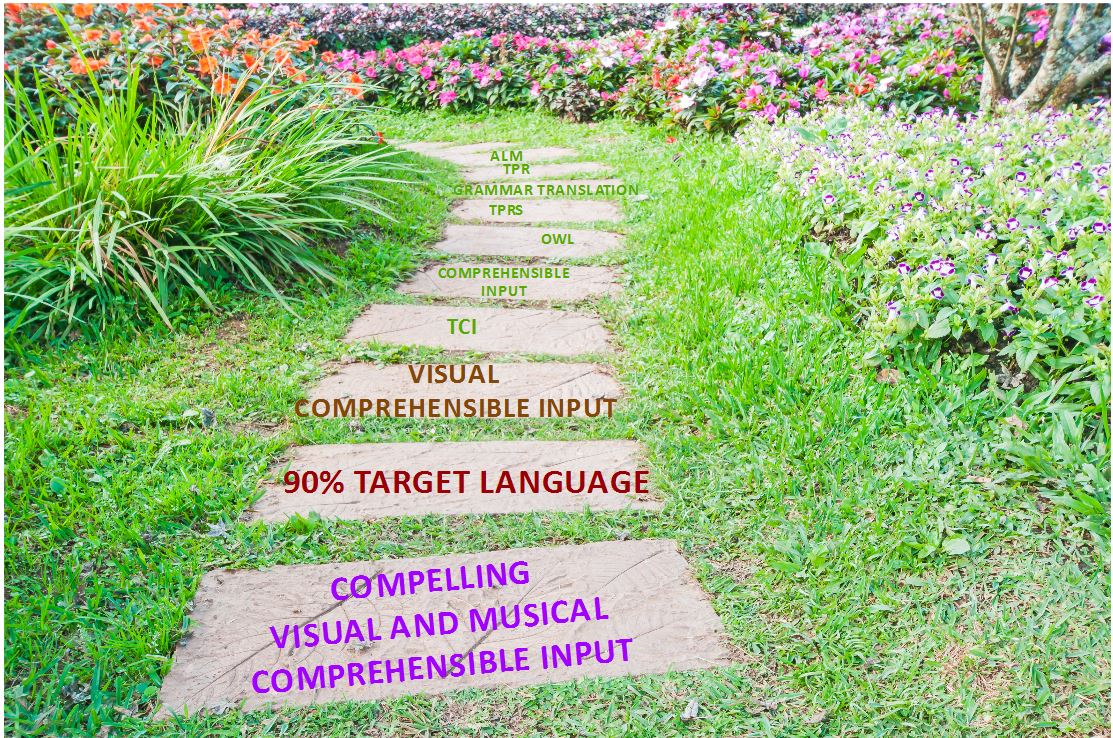
The defining moment when language teachers realize that comprehensible input is the key to students learning a language is a mixed blessing: they are excited with possibilities and overwhelmed with how to do it. This blog reflects the best practices for world language teachers in 2017 using technology to reach the LINKSTERS, also known as Generation Z, those born after 2000.
This blog is a response to a teacher who reached out to me on my TPT Q & A page and wrote:
So I am loving your slides! I have a few questions and I wanted to ask you. I see that your site speaks about TPRS and now VCI. Do you use both? Or do you now primarily use VCI?
My 90% Target Language Journey.
Today’s TPRS is very different from what Blaine actually was using in his classroom.
I first learned about TPRS back around 199 something when Blaine Ray and Susi Gross started working together. I think we all had breakfast together in New Jersey during their second seminar together.
Back then, on that second day of the seminar, I was earnestly telling him that I couldn’t give up “my song of the week” and “my daily newspaper headline readings”  –
–  all wonderful additions to my classroom as we had just installed the internet in school. Susi was smiling and tilting her head as she taught the way I did, all the while Blaine insisted we drop everything and do his seven-step process. With Susi’s influence, it was whittled down to five steps, and many best practices were tucked under the TPRS umbrella.
all wonderful additions to my classroom as we had just installed the internet in school. Susi was smiling and tilting her head as she taught the way I did, all the while Blaine insisted we drop everything and do his seven-step process. With Susi’s influence, it was whittled down to five steps, and many best practices were tucked under the TPRS umbrella.  Susi also softened some of Blaine’s examples of dealing with non-compliant students, his insistence that he never prepped for class, rather played golf 20 minutes after the last bell rang, and his stories that crossed certain lines; Susi made TPRS become a more gentle and loving way of teaching. Together they became a dynamic teaching duo, attracting many great teachers. Their message to teachers to use more target language with the students and focus less on textbook activities resonated with many. They added wonderful teaching practices like
Susi also softened some of Blaine’s examples of dealing with non-compliant students, his insistence that he never prepped for class, rather played golf 20 minutes after the last bell rang, and his stories that crossed certain lines; Susi made TPRS become a more gentle and loving way of teaching. Together they became a dynamic teaching duo, attracting many great teachers. Their message to teachers to use more target language with the students and focus less on textbook activities resonated with many. They added wonderful teaching practices like  “embedded reading” and “movietalk” to the TPRS umbrella.
“embedded reading” and “movietalk” to the TPRS umbrella.  Susi started doing workshops on “the song of the week.” It became an energizing movement among World Language educators. It also became more fluid. Certain parts, like gesturing the vocabulary, became optional and not mandatory as committed teachers tried different things to test what worked best with their students, and reported back the results.
Susi started doing workshops on “the song of the week.” It became an energizing movement among World Language educators. It also became more fluid. Certain parts, like gesturing the vocabulary, became optional and not mandatory as committed teachers tried different things to test what worked best with their students, and reported back the results.
Some of the TPRS gurus stopped teaching and focused on giving seminars and creating books. In my opinion, while they represented good teaching, they stopped representing the latest teaching practices available with technology.
Those who stopped teaching never had to teach with high-stakes testing and with compliance with national goals. They never had to teach students who have no other alternatives because the electives have all been cut. They never taught students with cell phones fact checking everything they said. They haven’t taught 1:1 and some missed teaching with an interactive board. Teachers who had stopped teaching believed they knew about our new reality, but they never lived it. With technology today, we can easily create compelling opportunities for students to interact spontaneously, reducing the novelty of circling and storytelling from the 90’s.
Predictably, there was a split in the TPRS camp! It was somewhat hushed up, but it fell along many of the beliefs that divide our country: the definition of marriage. Groups split off and CI and TCI were two of them.
About this time, ACTFL started developing the idea of 90% Target Language teaching earlier than the traditional benchmark of the third year of the language.
Along the path to learning with 90% TL during the first year, students must engage with compelling, comprehensible input. Dr Krashen’s ideas about comprehensible input and not pushing for output gained more momentum.
A lively debate has grown as to the ‘best’ path to total comprehensible input. Probably 99% per cent of teachers in the classroom today support eclectic activities as stepping stones to create the right path for each individual teacher. But there are a vocal few who insist that only their way that matches their teaching voice is the universal path for all. Some appear to have plenty of time to bully and belittle people who choose a different path to comprehensible input. Hence, a lot of us don’t engage in theory debates, we use the latest technology and other tools to prepare lessons that bring remarkable results for our classroom management and for our students speaking in the target language.
While I can choose among many different kind of activities suggested by TPRS, CI, OWL, AIM, and TCI, my students have taught me that they need visual support for their comprehensible input.
I started offering a slide for every activity and then for transitions and the next thing I knew, the whole class was scripted with support and the Spanish One students and I were able to stay in the target language by using Visual Comprehensible Input.
I thought I was set until retirement when a funny thing happened. The class of ’95 wanted me to join FaceBook so that I could be up on all of their activities for the reunion. From there, I was able to connect with some of my friends from when I lived Venezuela. They are desperate for work and money. Next thing I know, I am paying them to sing my songs and to bring my storyboards to life in videos. Now all of my transitions are supported by videos and the number of slides needed to tell students what to do has been reduced to a 30 second clip showing them what to do.
I am astounded. On the second day of class, I showed the “Saquen la Tarea” transitional video, and as I walked around the room, the students each said “La tengo.”
We haven’t looked back. While I don’t know much about research, I believe that the focus on Dr. Krashen’s theory only goes so far. Once I introduce musical transition videos, the output gushes out of their mouths like nothing I have ever seen.
Sure they sing my Sr. Wooly songs with enthusiasm and asked to go to the bathroom, but that is just one of my 50 musical survival slides. The 35 transition videos with the announcer voice and the 10 transition videos with the songs and the 50 musical survival slides all have entered a different part of the brain, in my opinion. I think the next step, is CVMCI Compelling Visual and Musical Comprehensible Input.
So, Olgie, to answer your question, I use many activities also used by TPRS, CI, AIM, TCI and OWL teaching voices, but the latest development is CVMCI. No theory, no research, just my classroom experience. I’ll be sharing what I believe to be cutting edge ideas in Lansdale, PA on October 5th, in Boston, MA at ACTFL on Friday, November 18th, and at Central States in Chicago on Friday, March 10, 2017.
These videos support some very desperate families in Venezuela. Read my blog about them and what you can do to help.


